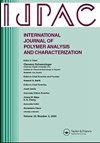用于光学设备的氧化铜/聚合物纳米复合材料的制备、结构和光学特性
IF 1.6
4区 工程技术
Q4 POLYMER SCIENCE
International Journal of Polymer Analysis and Characterization
Pub Date : 2024-10-02
DOI:10.1080/1023666X.2024.2397392
引用次数: 0
摘要
采用浇铸溶液法制备了聚 4-氯苯胺 P(4ClAni)/CuO 薄膜,该薄膜由 CuO 与聚 4-氯苯胺 P(4ClAni) 混合而成。XRD 证实了 P(4ClAni)/CuO 薄膜的成功制备。此外,还测定了 CuO 对光学特性的影响。CuO 分别将折射率从 P(4ClAni) 的 1.09 提高到 P(4ClAni)/CuO-1 的 1.11 和 P(4ClAni)/CuO-3 的 1.19,而振荡能 E0 则从 P(4ClAni)/CuO-1 的 4.29 eV下降到P(4ClAni)/CuO-1的3.57 eV、P(4ClAni)/CuO-2的3.12 eV和P(4ClAni)/CuO-3的3.06 eV。随着 CuO 比率的增加,P(4ClAni) 和 CuO 之间的电荷转移提高了光导率。这表明,P(4ClAni) 和 CuO 之间的相互作用改变了复合材料的电子结构。此外,等离子体频率从 0.87 x 1012 s-1 增加到 2.32 x 1012 s-1。当改变 P(4ClAni)/CuO 的极化时,光学参数就会发生这些变化。该研究阐明了加入 CuO 纳米粒子作为填料在改善 P(4ClAni) 结构性能方面的优势。研究结果表明,P(4ClAni)/CuO 复合材料的成功制备具有新颖的特性,可应用于柔性光学器件。本文章由计算机程序翻译,如有差异,请以英文原文为准。
Fabrication, structure and optical characteristics of CuO/polymer nanocomposites materials for optical devices
The films of P(4ClAni)/CuO, which formed of mixing poly 4-chloroaniline P(4ClAni) by CuO, were fabricated by the casting solution method. The XRD confirmed the successful prepration of the P(4ClAni)/CuO films. Additionally, the effect of CuO on the optical characteristics was determined. The CuO increased the refractive index from 1.09 for P(4ClAni) to 1.11 for P(4ClAni)/CuO-1, and 1.19 for P(4ClAni)/CuO-3, respectively, while the oscillation energy E0 dropped from 4.29 eV for P(4ClAni) to 3.57 eV for P(4ClAni)/CuO-1, 3.12 eV for P(4ClAni)/CuO-2, and 3.06 eV for P(4ClAni)/CuO-3. The charge transfer between P(4ClAni) and CuO increased optical conductivity as the CuO ratios increased. This suggests that modifications in the electronic structure of the composite due to the interactions between P(4ClAni) and CuO. Also, the plasma frequency increased from 0.87 x 1012 s−1 to 2.32 x 1012 s−1. These changes in optical parameters occurred when the polarization of the P(4ClAni)/CuO was altered. The study elucidated the advantages of incorporating CuO nanoparticles as fillers in improving the properties of P(4ClAni) structures. The obtained results indicate the P(4ClAni)/CuO composites were sucessfuly fabricated with novel characteristics that can be applied in flexible optical devices.
求助全文
通过发布文献求助,成功后即可免费获取论文全文。
去求助
来源期刊
CiteScore
3.50
自引率
5.30%
发文量
37
审稿时长
1.6 months
期刊介绍:
The scope of the journal is to publish original contributions and reviews on studies, methodologies, instrumentation, and applications involving the analysis and characterization of polymers and polymeric-based materials, including synthetic polymers, blends, composites, fibers, coatings, supramolecular structures, polysaccharides, and biopolymers. The Journal will accept papers and review articles on the following topics and research areas involving fundamental and applied studies of polymer analysis and characterization:
Characterization and analysis of new and existing polymers and polymeric-based materials.
Design and evaluation of analytical instrumentation and physical testing equipment.
Determination of molecular weight, size, conformation, branching, cross-linking, chemical structure, and sequence distribution.
Using separation, spectroscopic, and scattering techniques.
Surface characterization of polymeric materials.
Measurement of solution and bulk properties and behavior of polymers.
Studies involving structure-property-processing relationships, and polymer aging.
Analysis of oligomeric materials.
Analysis of polymer additives and decomposition products.

 求助内容:
求助内容: 应助结果提醒方式:
应助结果提醒方式:


